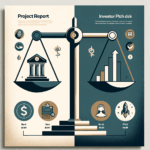How can technology improve the accuracy of CMA and bank project reports?
For any small business owner, securing a bank loan is a critical milestone for growth. You’ve poured your heart into your business plan, but the fear of rejection looms large, often due to a minor, overlooked error in your financial documents. This is a common and stressful reality. This guide is designed to show you precisely how technology can improve CMA accuracy and the quality of your bank project reports, significantly boosting your chances of loan approval. Manually prepared Credit Monitoring Arrangement (CMA) reports and bank project reports are unfortunately susceptible to human error, which can cause frustrating delays or even outright rejection from lenders. The good news is that by integrating modern tools and software, you can eliminate these risks. Adopting technology for CMA accuracy in India is no longer a luxury for large corporations; it is a vital strategy for ambitious small and medium-sized enterprises aiming for success.
The Critical Role of Accuracy: Understanding CMA and Bank Project Reports
Before we explore the technological solutions, it’s essential to understand why these documents are so important and why banks demand such a high degree of precision. These reports are the financial bedrock upon which a bank builds its decision to lend you money. Any crack in that foundation, no matter how small, can jeopardize the entire structure of your loan application.
A CMA report is a detailed financial document that provides a deep analysis of a company’s past performance and, more importantly, its projected financial health for the upcoming years. It is a standardized format that most banks in India require for loan processing. Lenders use it to understand your company’s ability to repay the loan by scrutinizing its core financial stability and operational efficiency. The key components typically include:
- Analysis of the Balance Sheet (past and projected)
- Profit and Loss (P&L) Statement (past and projected)
- Ratio Analysis to assess liquidity, profitability, and debt
- Fund Flow Statement showing the movement of funds
- Maximum Permissible Bank Finance (MPBF) calculation
A Bank Project Report is a more comprehensive blueprint that details the viability of a proposed business venture or expansion plan. While a CMA report focuses heavily on financial data, a project report covers the entire business case, including technical feasibility, marketing strategies, management structure, and economic viability. Its goal is to convince the bank that your project is not just a good idea but a sound, profitable investment.
For both these documents, 100% accuracy is non-negotiable. Banks rely entirely on the data presented to assess your creditworthiness and the potential return on their investment. A simple typo in a sales projection, an incorrect formula in a cash flow statement, or an inconsistency between the P&L and the Balance Sheet can be a major red flag. Such errors signal carelessness at best and a lack of financial control at worst, forcing bankers to conduct extra scrutiny or reject the application. Therefore, learning how to improve bank project report accuracy is a critical skill for any entrepreneur seeking capital.
Key Ways Technology Can Improve CMA Accuracy and Project Reports
The shift from manual, error-prone spreadsheets to automated, intelligent systems is the single most powerful change you can make to your loan application process. Technology tackles the core weaknesses of manual preparation, transforming your financial reports from a liability into a powerful asset. Let’s explore the specific ways these advancements can fortify your financial documentation.
1. Automation to Eliminate Human Error
The most common source of inaccuracies in financial reports is manual data entry. Whether it’s a simple typo, a copy-paste error, or a miscalculation from a complex formula, these small mistakes can have significant consequences. Manually compiling data from various sources like bank statements, invoices, and expense receipts is tedious and leaves ample room for error. Every manual touchpoint is a potential point of failure.
This is where automation becomes a game-changer. Modern accounting software and specialized financial reporting tools can directly integrate with your bank accounts, invoicing systems, and other data sources. They automatically fetch, categorize, and reconcile transactions, creating a clean and reliable dataset. This eliminates the need for manual data entry, drastically reducing the risk of human error. This automation is a fundamental bank project report improvement technique that ensures the foundational data of your report is solid, consistent, and error-free from the very beginning.
2. Sophisticated Financial Projections and Forecasting
Banks don’t just want to see your past performance; they need to be convinced about your future. Traditional financial projections, often built on basic Excel templates, can be overly simplistic and may fail to inspire confidence. Lenders are looking for realistic, data-backed forecasts that demonstrate a deep understanding of your business and market dynamics.
Technology elevates your forecasting capabilities from guesswork to data science. Modern software uses historical financial data and sophisticated algorithms to generate more accurate and dynamic projections for sales, expenses, and cash flow. These tools can run multiple “what-if” scenarios instantly. For example, you can model the impact of a 10% increase in raw material costs or a 15% drop in seasonal sales on your profitability and cash reserves. This ability to present robust, scenario-tested projections shows the bank you have a firm grasp on your business’s financial future. This is a prime example of leveraging technology for CMA reports to build a compelling and defensible case for your loan.
3. Real-Time Data and Cloud Integration
A financial report prepared on the first of the month can be significantly outdated by the time a banker reviews it two weeks later. In a dynamic business environment, sales are made, expenses are incurred, and your financial position changes daily. Submitting a report based on stale data can lead to questions from the bank and delays in processing.
Cloud-based accounting platforms (like Tally on Cloud, Zoho Books, or QuickBooks) solve this problem by creating a single source of truth for your financial data. Because all information is updated in real-time and accessible from anywhere, the CMA or project report you generate always reflects the most current financial position of your company. This ensures that the figures you present are not just accurate but also relevant. The widespread adoption of these platforms highlights the significant technology impact on CMA reports India, as businesses increasingly move towards live, connected financial ecosystems.
4. AI and Machine Learning for Deeper Insights
Beyond automation and real-time data, Artificial Intelligence (AI) and Machine Learning (ML) represent the next frontier in financial analysis. These advanced technologies can analyze vast amounts of financial data to uncover patterns, identify anomalies, and flag potential risks that even a seasoned accountant might miss.
For instance, an AI-powered tool can analyze your cash flow patterns and predict a potential shortfall three months in advance, allowing you to address it proactively in your project report. It can benchmark your financial ratios against industry averages, providing context and highlighting your competitive strengths. This deeper level of analysis makes your report more robust, insightful, and defensible under the bank’s scrutiny. Incorporating these tools demonstrates that you are utilizing the latest project report accuracy technology advancements to manage your business effectively.
Essential CMA Report Accuracy Tools for Indian Businesses
Adopting technology doesn’t have to be an overwhelming overhaul. You can start by integrating a few key tools that work together to streamline your financial reporting process. Here are the main categories of CMA report accuracy tools India that businesses should consider:
- Accounting Software: This is the foundation. Tools like TallyPrime, Zoho Books, and QuickBooks are the central repository for all your financial transactions. Ensuring this source data is clean, up-to-date, and well-organized is the first and most crucial step towards accurate reporting.
- Specialized CMA & Project Report Software: Several dedicated software solutions are designed specifically to prepare CMA and project reports. These tools can often import data directly from your accounting software (like Tally) and automatically generate the entire report in bank-prescribed formats, complete with all necessary statements and ratio analyses.
- Advanced Spreadsheet Tools: For businesses with strong in-house financial skills, tools like Microsoft Excel with Power Query or Google Sheets with specialized add-ons can be powerful. They can automate data cleaning, consolidation, and the creation of dynamic financial models, bridging the gap between basic spreadsheets and dedicated software.
- Business Intelligence (BI) Dashboards: For larger or more complex projects, BI tools like Microsoft Power BI or Tableau offer advanced data visualization and analysis capabilities. They can transform raw financial data into intuitive charts and dashboards, making it easier to present complex information clearly and persuasively in your project report.
How TaxRobo Ensures Accuracy in Your Financial Reports
While technology provides powerful tools, it’s the combination of these tools with expert financial knowledge that delivers truly exceptional results. At TaxRobo, we bridge that gap. We understand that as a business owner, your focus should be on growth, not on wrestling with complex financial software and banking compliance.
Our team of financial experts leverages cutting-edge technology to prepare error-free, professionally formatted, and fully compliant CMA and bank project reports. We combine the power of automation to ensure data integrity with the strategic insights of seasoned professionals who understand exactly what banks are looking for. This synergy is key to accuracy enhancement in bank reports. We handle the entire process, from data consolidation and analysis to forecasting and final report generation, saving you invaluable time, eliminating stress, and maximizing your chances of securing the financing you need to grow.
Conclusion
In today’s competitive business landscape, relying on outdated manual methods for critical financial reporting is a risk you cannot afford to take. The path to securing a business loan is paved with accurate, consistent, and professionally presented data. Technology offers a clear solution by automating processes, eliminating human error, enabling sophisticated forecasting, providing real-time data, and uncovering deeper financial insights. For any modern business in India seeking growth capital, leveraging technology to improve CMA accuracy is not just an advantage—it’s an absolute necessity.
Stop struggling with complex spreadsheets and worrying about costly errors. Take the first step towards a seamless and successful loan application.
Contact TaxRobo for a consultation today and let our experts prepare accurate, bank-ready CMA and project reports for your business.
Frequently Asked Questions (FAQs)
Q1: Can I prepare a CMA report myself using online tools?
A: While online tools are helpful for calculations and formatting, they cannot replace financial expertise. A CMA report’s strength lies in the validity of its underlying assumptions about sales growth, expenses, and market conditions. An incorrect assumption can invalidate the entire report, even if the calculations are technically correct. Professional assistance from a service like TaxRobo ensures you have both technological accuracy and sound financial expertise backing your application.
Q2: What is the single biggest mistake in manual CMA report preparation?
A: The most common and easily spotted mistake is inconsistency across financial statements. For example, the net profit shown in the Profit & Loss statement must logically connect to the change in reserves and surplus on the Balance Sheet. Similarly, the movement of cash in the Fund Flow statement must reconcile with the opening and closing cash balances. Automation and integrated software easily solve this by ensuring all statements are dynamically linked and internally consistent.
Q3: How does technology help if banking regulations or formats change?
A: This is a significant advantage of using professional software and services. Banks and the RBI periodically update their guidelines and reporting formats. Reputable software providers and expert firms like TaxRobo constantly monitor these changes and update their systems and templates accordingly. This ensures your report is always compliant with the latest requirements from the Reserve Bank of India and specific lenders, saving you from having to rework your documents.
Q4: Is investing in this technology expensive for a small business?
A: Not at all. Many powerful cloud-based accounting platforms operate on affordable monthly subscription models, making them highly accessible for small businesses. More importantly, the cost of using a professional service like TaxRobo to prepare these reports is a strategic investment. This cost is often far less than the opportunity cost of a delayed or rejected loan, which could stall your growth plans and impact your business’s momentum.



